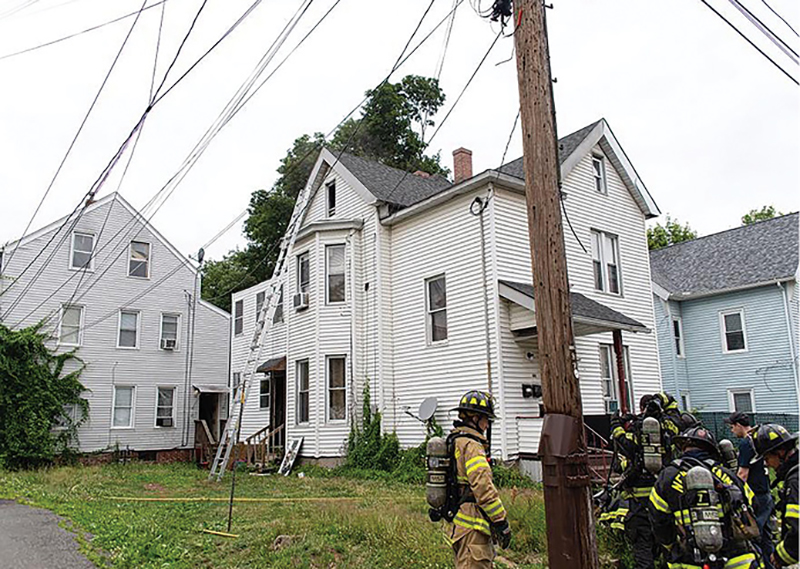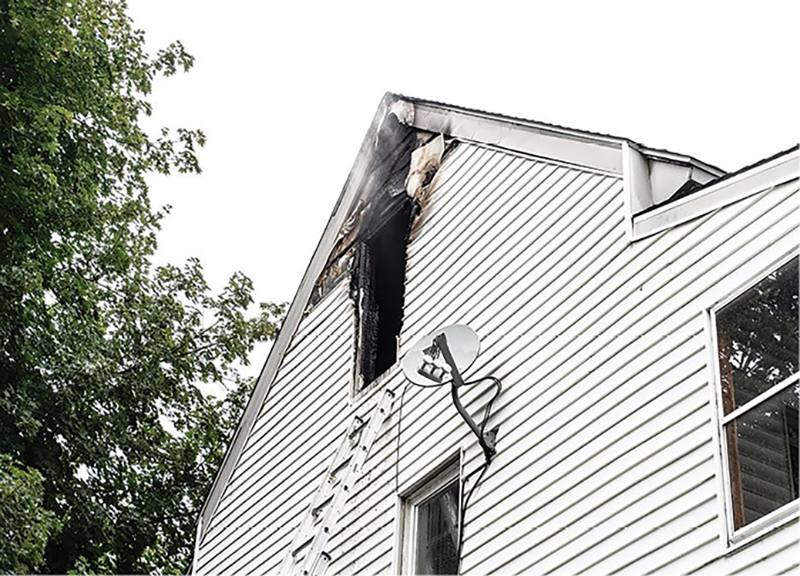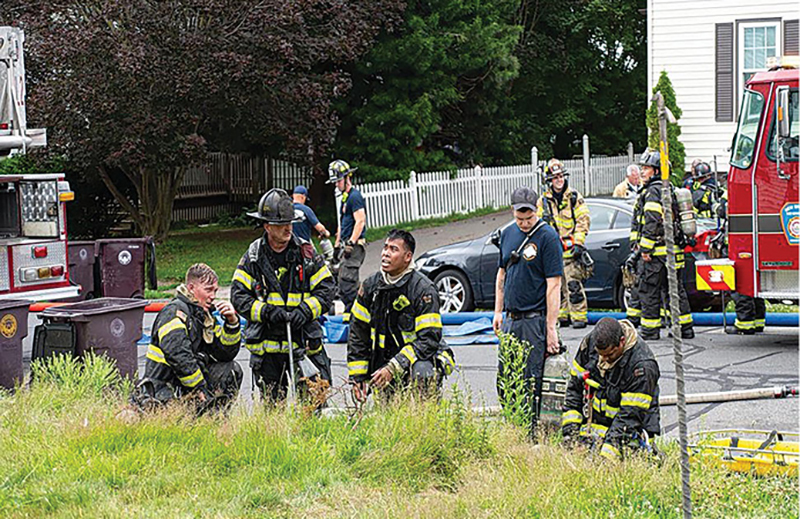WHAT WE LEARNED ❘ By Alex Deering
While returning from training, New Britain (CT) Fire Department Ladder 2 received a run for a structure fire at 64 Fairview Street, reported as a fire in the attic. With the address just blocks away, we were the first on scene. On arrival, we saw smoke showing from the C side of a 2½-story wood (balloon) frame construction multiple dwelling. While many of these buildings are two-family occupancies, with the half-story (attic) typically slated for storage, we are finding converted apartments and living areas located within that space.
- Training Minutes: The Can
- Mike Ciampo on the Many Uses of the Can
- Training Minutes: Modifications to the Can
- Training Minutes: The Can–Locate, Confine, Extinguish
While dismounting the ladder apparatus from the “irons” position with a thermal imaging camera (TIC), a set of irons, and a 2½-gallon pressurized water extinguisher, I began a visual size-up. Hearing screams and shouting from the A side, we headed that way to evacuate the occupants from that portion of the structure (photo 1).

1. A view of the fire building from the A-B corner. (Photos by Michael Carenza Jr.)

2. The C-side gable window, serving the attic bedroom, which was venting fire on arrival.
In the Home
At the front door, a man informed us there was someone on the second floor trying to rescue his dog. I radioed a report to the captain, who was conducting a 360° size-up, and we made entry to locate the occupant. Once we made contact with the occupant, we instructed him to evacuate the structure, which he did only after retrieving his dog. While exiting, the occupant identified the location of the attic access, which was a door leading to a stairway on the D side of the structure in between the living room and the kitchen.
Once inside, we forced the door to the attic from its hinges and moved it into the kitchen, as it was hindering access/egress. We encountered severe hoarding conditions throughout the stairway, which required us to clear a path for Engine 5’s nozzle team to advance. Once completed, we masked up at the base of the stairs and continued up to the attic. We were met with heavy smoke, high heat, and more hoarding conditions. Unbeknownst to us, the attic was partially finished with storage at the top of the stairs and a converted bedroom at the C side of the building, where the seat of the fire was located. Referred to as a “bonus room,” this additional living space is considered part of the second-floor unit and typically has no secondary means of egress.
Finding the Fire
As we made our way to find the fire, the captain pulled back in the narrow path that was carved into the contents so I could move in with the water can to confine the fire until the nozzle team arrived. The outside vent firefighter had radioed to all units that fire was self-venting from the C-side attic window (photo 2). I proceeded down the hallway toward the seat of the fire. I used the TIC to scan the area; the spot temperature reading was nearly 500°F at the top of the fire room doorframe. Rotating the TIC 90° inward (orienting the screen vertically) and scanning the surroundings provided a complete floor-to-ceiling view—revealing the piles of contents along the route ahead. My self-contained breathing apparatus (SCBA) mask as well as the TIC screen and lens were continuously getting smoke-stained; I had to wipe them constantly to restore clarity.

3. Ladder 2 spotted the apparatus to get the turntable under the wires and shot the valley of the D-side dormer to access the roof and perform vertical ventilation.
The TIC had now shifted into high-heat/low-sensitivity mode, indicated by the green triangle/square symbol in the top-left corner of the screen. We observed thermal currents exhausting from the fire room into the overhead, which gained considerable velocity within seconds. The TIC readings, along with the physical heat I was feeling, told me conditions were deteriorating. Without prompt intervention, we would have been chased down the stairs in short order.
I put the TIC down and repositioned for a better view of conditions. Visibility off the floor was about three feet. Heavy fire and flames were licking out in the overhead. These were all preflashover conditions.
Approximately five feet away from the doorframe, I aimed the nozzle of the water can and applied the straight stream to the header to wet the top of the doorframe. This cooled the overhead and kept the flames out of the space we were in. While this action did not extinguish the fire, the stream from the water can was effectively controlling it. Knocking back the flames kept the fire confined to the room of origin and maintained tenability until the nozzle team got into place.
From my vantage point, I was now able to identify a bed toward the C-D corner and a rocking chair midway into the room from the doorway. Unfortunately, there was no door to the fire room to control, which was later found leaning on the bed, toward the backside of the room.
The Conditions, Actions, Needs (CAN) Report
Engine 5 stretched in with a 1¾-inch handline equipped with a 15⁄16-inch smooth bore nozzle and advanced up to the fire floor. With the conditions still “lights out,” I provided a face-to-face report to the probationary firefighter on the nozzle, operating at his first fire, to quickly identify the CAN, which also included the layout of the approach to the seat of the fire.
The CAN report advised him that there was a doorway with no door and flames licking out into the hallway. He was instructed to open the line and make a push toward the fire room and not close the line. Realizing the need to assist in the handline’s advancement through the cramped and cluttered conditions, with the hose making a 180° bend around the newel post, I moved out of the way and began accomplishing that task. Due to the severity of the hoarding conditions, I had to crawl over piles of contents, momentarily elevating my upper body into the high heat of the thermal layer above, which caused minor burn injuries.
Under Control
Within 60 to 90 seconds of flowing water on the fire, the outside team of Ladder 2 had accessed the roof via the bucket of the ladder tower and cut a hole directly over the fire room. With only one gable window having been vented previously (failed by the fire prior to our arrival), the vertical ventilation provided the additional relief necessary for the nozzle team to make the push.
As the smoke and heat lifted, we advanced into the fire room and completed the primary search. After we conducted some overhaul and checked for any fire extension, the fire was placed under control (photo 3).
Lessons Learned
1. Training is critical.
Reading the conditions and making critical decisions, based on your experience, training, and understanding of fire behavior, are paramount when operating at a working fire. Shortly before this fire, I attended a lecture and hands-on class called “Without the Protection of a Hoseline: The Uncomfortable Reality.” With this fire occurring not even 30 days later, I was able to readily use the training I obtained that day (search, door control, pressurized water can abilities) and apply it to the fireground, where seconds counted, and my actions positively changed the dynamics of the fire.
The similarities between the live fire training evolutions and the actual fire were striking. It was as if someone had taken the burn trailer and put it in the attic of that multiple dwelling. We had lights-out conditions, high heat, and heavy fire in the next room, with flames licking out at us. I was able to put the water can to work and knock back the fire to confine it to the bedroom, which helped keep the environment in check. The only component missing was the door to control after the water can was depleted, which would have isolated the fire to the room of origin and would have dramatically improved conditions in the rest of the attic space.

4. The nozzle team of the first-due engine company and the inside team of the first-due ladder company take a break after knocking down the fire.
2. Carry a water can.
Since we were first-due on the ladder without the protection of a handline, the 2½-gallon water can was our initial lifeline as we initiated our search for life and the fire. If used correctly, a water can has the ability to knock down smaller incipient fires and knock back moderate growth fires, keeping them in check while the nozzle team gets the handline into position. While the water can will probably not extinguish the fire, it can often suppress it enough to get the door to the room controlled—isolating the fire (ideally to the room of origin).
Gaining control of the door also allows a search past the fire room. The extinguisher can be used in short blasts on escaping flame at the top crack of the door, confining the fire to the room. Understanding the limitations of the water can, especially when the door to the fire room cannot be controlled, and maintaining a position where you can easily back out, if necessary, are critical.
3. Put your senses to work.
During the hands-on training, my body physically experienced the same heat conditions in the same areas (my head and shoulders) at the points where my PPE was compressed against my body.
From a visual perspective, the C-side window had failed, and the fire was self-venting in a bidirectional flow on our arrival. As we made entry to the attic, I could see the unidirectional (intake) flow we created after forcing the door to the stairway below, and the fire room window transitioned into a unidirectional (exhaust) flow. Because the single window was the only outlet available, the growing fire quickly overwhelmed it. The size of the opening proportionally limited its exhaust capabilities, so it was unable to fully relieve the conditions in the room.
With excessive heat and smoke collecting and causing the thermal balance to drop, the pressure began to build up and seek the next path of least resistance, exiting the room through the open doorway and into the hallway. These conditions weren’t relieved until the roof was vented by the outside team of Ladder 2. If there was no ventilation, however, the hallway would have become untenable in a short period of time, forcing our retreat.
Getting below the smoke, firefighters will be able to better observe the layout of the room and identify key landmarks from a distance. Having been in this environment previously, in a controlled setting, I felt comfortable. At the same time, I fully understood and respected the severity of the conditions around me. Because of the recent training, this situation became part of my “mental files.”
4. Establish defined riding positions.
Our department’s standard operating procedures lay the groundwork for every riding position on each responding apparatus. The four positions and their critical tasks for both of our ladder companies are as follows: the officer and the firefighter riding behind them (aka the irons firefighter) marry up and form the inside team to locate the seat of the fire; perform forcible entry, search, and overhaul; and assist the engine companies as needed.
The driver and the firefighter behind them, the outside vent (OV) firefighter, marry up and form the outside team. The OV assists the driver in spotting the apparatus, performs a 360° size-up, raises portable ladders, and conducts horizontal ventilation as needed (maintaining the discretion to perform vent-enter-search). If vertical ventilation is required, the outside team accesses the roof to perform the operation together.
Maintaining defined riding positions establishes the roles and responsibilities ahead of time. When responding to a fire, regardless of the circumstances, these standing orders allow the firefighters and officers to immediately execute once the maxi-brake is popped. While every incident may be different, the critical tasks that must be completed remain largely constant. Experience and training will help you recognize the conditions and the best way to specifically execute those operations. The defined riding positions not only streamline the deployment of the crews and communications, but they provide the incident commanders with a sequence of events and key benchmarks for tracking accountability and progress (photo 4).
Preparation Counts
My training and preparation readied me for this incident and the operation was largely a success. Being able to identify preflashover conditions and using the water can to prevent the fire from extending, all while waiting for the nozzle team to advance in with a handline, was of extreme value. The potential signs for this turning into a catastrophe were recognized early and addressed accordingly. I hope learning about this experience allows others to recognize the importance of reading conditions, as well as getting off the apparatus with a water can and being able to use it properly, when you are operating without the protection of a hoseline.
Author’s note: Thanks to Dan Gordon and Cal Brennan from Flash Fire Training for a realistic and thorough training program. Dan Gordon will present “Without the Protection of a Hoseline: The Uncomfortable Reality” at FDIC 2024.
Alex Deering has been in the fire service for 13 years is a firefighter with the New Britain (CT) Fire Department assigned to Ladder 1. He previously worked for the Torrington (CT) Fire Department for nine years as well as served as a firefighter with the United States Air Force for six years.

